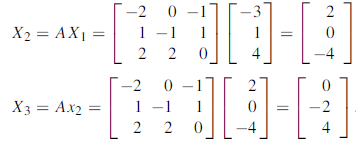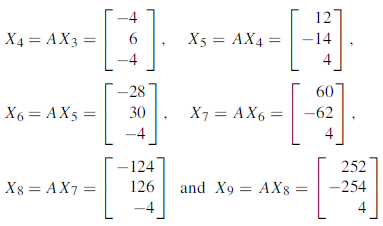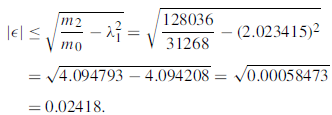Unit-5
Boundary Value problems
This method is used to solve bounded value problem.
The general two-point linear boundary value problem

With boundary condition

To solve this problem by using finite difference, we divide the interval [a, b] into n sub interval so that  .
.
The approximated function f(x) at the points 
………
We use the following central difference formula:


We substitute these value in the given equation and apply the boundary condition to calculate the value of the unknown.
Example1: Solve the boundary value problem defined by

by finite difference method. Compare the solution at y (0.5) by taking h=0.5 and h=0.25.
Given equation 
With boundary condition 
By finite difference method
 …. (iii)
…. (iii)
Putting(iii) in (i) we get
 …. (iv)
…. (iv)
For h=0.5, here for  which corresponds to
which corresponds to 
For i=1 in equation (iv) we get




For h=0.25, here 
Which corresponds to 
For i=1 in equation (iv) we get



For i=2 in equation (iv) we get



For i=3 in equation (iv) we get



From equation (v), (vi) and (vii) we get



On solving above triangular equation we get

Hence for h=0.5 we get y (0.5) =0.44444
And for h=0.25 we get y (0.5) =0.443674
Example2: Solve the bounded value problem

With boundary condition 
Given equation

With 
By finite difference method
 …. (3)
…. (3)
Putting (3) in equation (1) we have
By finite difference method
 …… (4)
…… (4)
Let h=1, we have 
Corresponds to 
For i=1 in equation (4) we get



For i=2 in equation (4) we get



For i=3 in equation (4) we get



From equation (5), (6) and (7) we get



On solving we get 
Example3: Solve the boundary value problem

With y (0) =0 and y (2) =3.62686
Given equation  …. (1)
…. (1)
With boundary condition y (0) =0 and y (2) =3.62686…. (2)
By finite difference method
 …. (3)
…. (3)
Substituting (3) in equation (1) we get
 …. (3)
…. (3)
Let h=0.5 then for 
Which corresponds to 
For i=1 in equation (3) we get



For i=2 in equation (3) we get



For i=3 in equation (3) we get



From equation (4), (5) and (6) we get



On solving we get 
Solving Eigen value problems (Power method)-
To find the approximate values of all the Eigen values and Eigen vectors, iteration method or power method is used.
Power method is used when only the largest and/or the smallest eigen values of a matrix are desired.
Procedure for Power method-
Step-1: First we choose an arbitrary real vector  , basically
, basically  is chosen as-
is chosen as-

Step-2: Compute  ,
,  ,
,  ,
,  , …………
, ………… Put
Put 
Step-3: compute  ,
,  ,
, 
Step-4: The largest Eigen value is

The error in  can be find as-
can be find as-

The Eigen vector corresponding to  is
is 
How do we determine the smallest Eigen value?
If  is the Eigen value of A, then the reciprocal
is the Eigen value of A, then the reciprocal  is the Eigen value of
is the Eigen value of  , then the reciprocal of the largest Eigen value of
, then the reciprocal of the largest Eigen value of  will be the smallest Eigen value of A.
will be the smallest Eigen value of A.
Example: Find the largest Eigen value and the corresponding Eigen vector of the matrix

Also find the error in the value of the largest Eigen value.
Sol.
Let us choose the initial vector

Then



Now put  , then-
, then-

Hence the largest Eigen value is-


And the corresponding Eigen vector is-

The error can be calculated as-

Key takeaways-


4. If  is the Eigen value of A, then the reciprocal
is the Eigen value of A, then the reciprocal  is the Eigen value of
is the Eigen value of  , then the reciprocal of the largest Eigen value of
, then the reciprocal of the largest Eigen value of  will be the smallest Eigen value of A.
will be the smallest Eigen value of A.
The general linear PDE of the second order in two independent variables is of the form-

Then there are three conditions-



Example: Classify the equation-

Sol.
Here A = 
Now

That means,
The equation is hyperbolic.
Example: Classify the equation 
Sol.
Here 

Hence the equation is parabolic.
Finite Difference Approximation
We construct a rectangular region R in the xy- plane and divide into network of sides  and
and  . The intersection points of the dividing lines are called the mesh point, nodal point or grid points.
. The intersection points of the dividing lines are called the mesh point, nodal point or grid points.

Then the finite difference approximation for the partial derivative in x-direction is



And

For  the above approximation is
the above approximation is
 …. (1)
…. (1)
 … (2)
… (2)
 … (3)
… (3)
And
 … (4)
… (4)
Similarly, we have the approximations for the derivatives with respect to y
 …. (5)
…. (5)
 …. (6)
…. (6)
 … (7)
… (7)
And
 …. (8)
…. (8)
Replacing the derivatives in any partial differential equation by their corresponding difference approximation (1) to (8), we obtain the finite difference similar to the given equations.
Simple Laplace’s Method:
The Laplace’s equation

Consider the Laplace’s equation in a region R with boundary C. Let R be a square region so that it can be divided into network of small squares of side h. Let the values of  on the boundary C be given by
on the boundary C be given by  and let the interior mesh points be as in figure
and let the interior mesh points be as in figure

The approximate function values at the interior point of the mesh can be calculated by the diagonal five-point formula of  in this order
in this order
 (bigger +)
(bigger +)
 (X form)
(X form)
 (X form)
(X form)
 (X form)
(X form)
 (X form)
(X form)
Similarly, the remaining quantities are calculated by using standard five-point diagonal formulas.
 (+ form)
(+ form)
 (+ form)
(+ form)
 (+ form)
(+ form)
 (+ form)
(+ form)
In this way all  are computed.
are computed.
Example1: Solve the Laplace’s equation  in the domain
in the domain

The initial values using five diagonal formula we have
Here  ,
, 





The remaining quantities are calculated by using standard five-point diagonal formulas.




Hence  and
and  .
.
Example2: Solve the Laplace’s equation for

The initial values using five diagonal formula we have
Here  ,
, 





The remaining quantities are calculated by using standard five-point diagonal formulas.




Hence  and
and  .
.
PDEs – Elliptical explicit method:
The Laplace’s equation

And the Poisson’s equation

are the example of elliptic partial differential equation.
The Poisson’s equation

This can be solved by interior mesh points of a square network when the boundary values are known. The standard five-point formula for Poisson’s equation is

After using the above formula, we get the linear equations in the pivotal values 
Then these are solved by Gauss Seidal Iteration formula
 .
.
Example1: Solve the elliptical equation for

The initial values using five diagonal formula we have
Here  ,
, 





The remaining quantities are calculated by using standard five-point diagonal formulas.




The Above is symmetric about PQ, so that  .
.
We will have iteration process using the Gauss Seidal Formula







First iteration: Putting  we get
we get







Second Iteration: Putting  , we get
, we get






Third Iteration: Putting  , we get
, we get






Fourth Iteration: Putting  , we get
, we get






Fifth iteration: Putting n=4 we get





 .
.
Example2: solve the Poisson equation


Let the point be defined by  At the point A,
At the point A,  . The standard five-point formula at point A is
. The standard five-point formula at point A is

Or 
Or  ….(i)
….(i)
Again, the standard five-point formula at the point B is

Or 
Or  ...(ii)
...(ii)
Similarly, the standard five-point formula at the point C

Or 
Or  …. (iii)
…. (iii)
Similarly, the standard five-point formula at the point D

Or 
Or  …. (iv)
…. (iv)
From (ii) and (iii) we get  =
= . Hence the iteration formula we have
. Hence the iteration formula we have


 .
.
First iteration: Putting  . Hence, we obtain
. Hence, we obtain



Second iteration: Putting n=1, we get



Third iteration: Putting n=2, we get



Fourth iteration: Putting n=3, we get



Fifth iteration: Putting n=4, we get



Sixth iteration: Putting n=5, we get



Since last two iteration are approximately equal, hence
 .
.
PDEs- parabolic explicit method:
The example of parabolic is one dimensional heat conduction equation
 ... (1)
... (1)
Where  is the diffusivity of the substance.
is the diffusivity of the substance.
Consider a rectangular mesh in  plane.
plane.

The spacing in x-direction is h and in t direction is k. Let the mesh point  or simply
or simply  we get
we get

And 
Substituting these in equation (1) we get

Or  … (2)
… (2)
Where  is the mesh ratio parameter.
is the mesh ratio parameter.
This formula gives the value of u at position  mesh points I nterms of known values of
mesh points I nterms of known values of  and
and  at the instant
at the instant  . It gives the relation between two-time level therefore known as two level formula.
. It gives the relation between two-time level therefore known as two level formula.
Also named as Schmidt explicit formula and is true for  .
.
At  the above formula reduces to
the above formula reduces to
 ... (3)
... (3)
Is known as Bendre-Schmidt recurrence relation which gives the value of u at internal mesh points with the help of boundary conditions.
Example1: Solve the equation  with the conditions
with the conditions  . Assume
. Assume . Tabulate u for
. Tabulate u for  choosing appropriate value of k?
choosing appropriate value of k?
Here  and let
and let  ,
,
Since 

 The Bendre-Schmidt recurrence formula we have
The Bendre-Schmidt recurrence formula we have
 …. (i)
…. (i)
Also given  .
.
 for all values of j, i.e., the entries in the first and the last columns are zero.
for all values of j, i.e., the entries in the first and the last columns are zero.
Since 
 (Using
(Using 
For  .
.
Putting 

Putting  successively we get
successively we get









These will give the entries in the second row.
Putting  in equation (i), we will get the entries of the third row.
in equation (i), we will get the entries of the third row.

Similarly,  successively in (i), the entries of the fourth rows are
successively in (i), the entries of the fourth rows are
obtained.

Hence the values of  are as given in the below the table:
are as given in the below the table:
| 0 | 1 | 2 | 3 | 4 | 5 | 6 | 7 | 8 | 9 | 10 |
0 | 0 | 0.09 | 0.16 | 0.21 | 0.24 | 0.25 | 0.24 | 0.21 | 0.16 | 0.09 | 0 |
1 | 0 | 0.08 | 0.15 | 0.20 | 0.23 | 0.24 | 0.23 | 0.20 | 0.15 | 0.08 | 0 |
2 | 0 | 0.075 | 0.14 | 0.19 | 0.22 | 0.23 | 0.22 | 0.19 | 0.14 | 0.075 | 0 |
3 | 0 | 0.07 | 0.133 | 0.18 | 0.21 | 0.22 | 0.21 | 0.18 | 0.133 | 0.07 | 0 |
Example2: Solve the heat equation

Subject to the conditions  and
and

 .
.
Take  and k according to Bendre-Schmidt equation.
and k according to Bendre-Schmidt equation.
Here  and let
and let  ,
,
Since 

 The Bendre-Schmidt recurrence formula we have
The Bendre-Schmidt recurrence formula we have
 …. (i)
…. (i)
Also given  .
.
 for all values of j, i.e., the entries in the first and the last columns are zero.
for all values of j, i.e., the entries in the first and the last columns are zero.
Since 
 .
.

 .
.

For 
Putting 

Putting  successively we get
successively we get



These will give the entries in the second row.
Putting  in equation (i), we will get the entries of the third row.
in equation (i), we will get the entries of the third row.

Similarly,  successively in (i), the entries of the fourth rows are
successively in (i), the entries of the fourth rows are
obtained.

Hence the values of  are as given in the below the table:
are as given in the below the table:
| 0 | 1 | 2 | 3 | 4 |
0 | 0 | 0.5 | 1 | 0.5 | 0 |
1 | 0 | 0.5 | 0.5 | 0.5 | 0 |
2 | 0 | 0.25 | 0.5 | 0.25 | 0 |
3 | 0 | 0.25 | 0.25 | 0.25 | 0 |
Example3: Use the Bendre-Schmidt formula to solve the heat conduction problem

With the condition  and
and  .
.
Let  we see
we see  when
when  .
.
The initial condition is  .
.
Also  .
.
The iteration formula is
 =
=
First iteration: Putting n=0, we get



Second iteration: Putting n=1, we get



Third Iteration: putting n=3, we get



Fourth Iteration: putting n=3, we get



Fifth Iteration: putting n=4, we get



Hence the approximate solution is 
Key takeaways-




5. The Poisson’s equation

References

